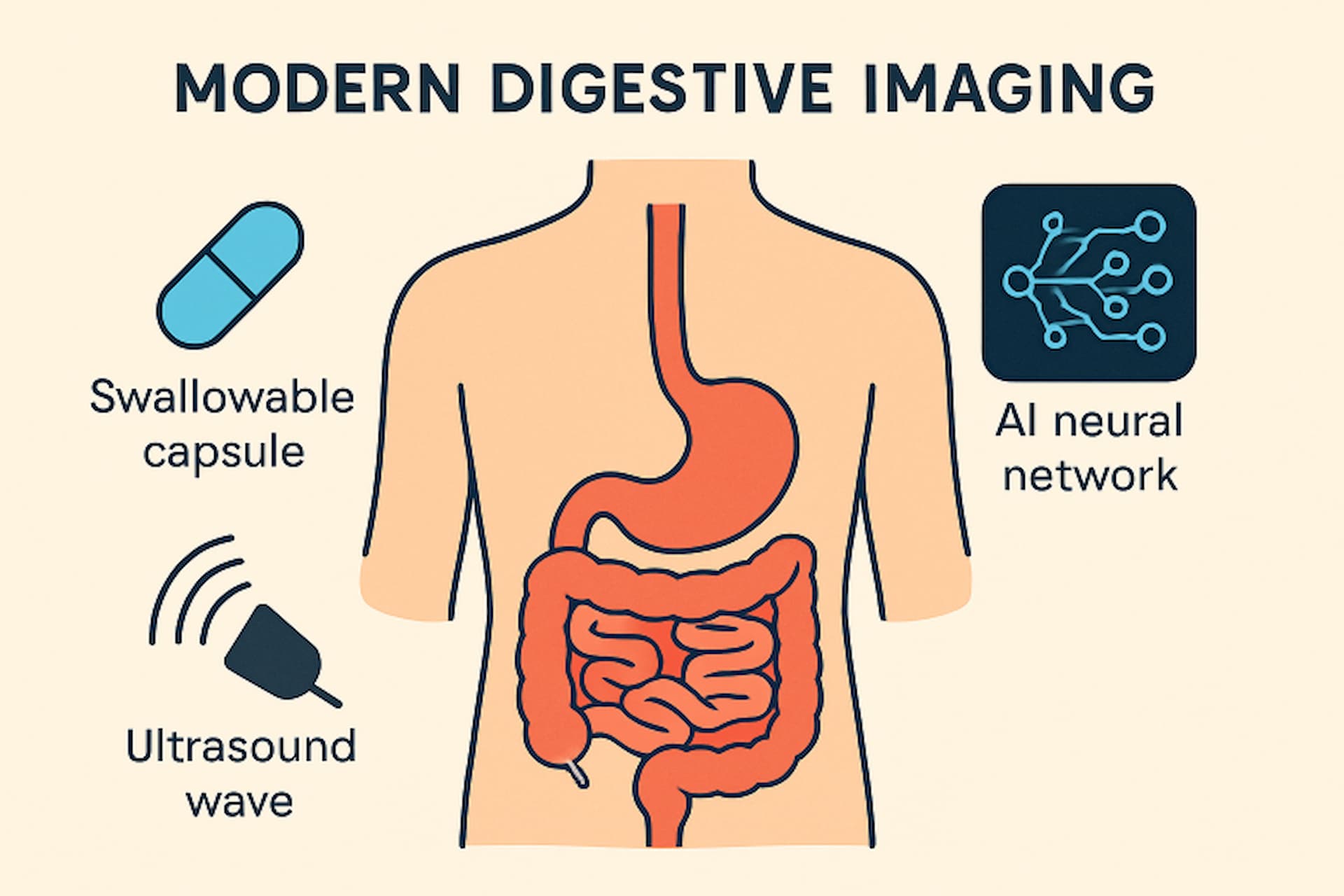Table of Contents
- Intestinal Ultrasound: A Non-Invasive Breakthrough
- Capsule Endoscopy: A Swallowable Camera
- Magnetically Controlled Capsules: Precision Without Sedation
- Shape-Shifting Ultrasound Stickers: Early Detection of Complications
- Artificial Intelligence in Endoscopy: Enhancing Detection Accuracy
- Benefits of Safer Imaging Techniques
- Conclusion
Medical imaging is ushering in a new era in digestive health care, transforming how gastrointestinal (GI) disorders are diagnosed and managed. Modern advancements offer safer, more precise, and less invasive ways to evaluate digestive conditions. One of the most notable innovations gaining momentum in both research and clinical settings is Intestinal Ultrasound. This breakthrough tool, among several others, is making GI diagnostics far safer and more accessible than ever before, reducing the risks associated with traditional methods while delivering fast, accurate results for patients and clinicians alike.
Patients now benefit from faster recovery times, less discomfort, and heightened peace of mind as healthcare systems adopt these innovative modalities. Techniques such as capsule endoscopy, magnetically controlled capsules, and AI-powered endoscopy are redesigning the way we approach disorders of the stomach, small intestine, and colon. With imaging improvements and novel monitoring tools like shape-shifting ultrasound stickers, the landscape of digestive health is rapidly evolving—delivering essential changes in personalized care. By linking the right technology to the right patient, such as employing Intestinal Ultrasound for real-time inflammatory bowel disease (IBD) evaluation, the road to accurate diagnosis and effective treatment is becoming smoother and safer for everyone.
Intestinal Ultrasound: A Non-Invasive Breakthrough
Intestinal Ultrasound (IUS) is redefining the approach to digestive diagnostics, especially in inflammatory bowel disease. Unlike conventional methods requiring exposure to radiation, anesthesia, or bowel prep, IUS delivers bedside visualization of bowel inflammation using safe ultrasound waves. This allows doctors to assess disease activity in real time and make instant treatment decisions, shortening the time from concern to care. Hospitals and clinics now increasingly rely on IUS for quicker, safer monitoring, providing patients with a level of comfort previously unattainable in GI imaging. This method also reduces healthcare costs and streamlines the diagnostic process for chronic digestive conditions.
Capsule Endoscopy: A Swallowable Camera
Capsule endoscopy brings a unique, patient-friendly solution for visualizing the small intestine—an area often elusive to standard endoscopic tools. Patients simply swallow a small capsule containing a miniature camera, which transmits thousands of detailed images as it travels naturally through the GI tract. This minimally invasive technique does not require sedation or recovery time and is especially useful in detecting sources of unexplained bleeding, Crohn’s disease, or small bowel tumors. Ongoing improvements have made capsule endoscopy more reliable and accessible, enabling doctors to locate issues quickly with minimal disruption to daily life.
Magnetically Controlled Capsules: Precision Without Sedation
For many patients, the idea of sedation or anesthesia is a major barrier to diagnostic procedures. Magnetically controlled capsules, such as the NaviCam system, provide a solution. Patients ingest a capsule that can be precisely maneuvered inside the digestive tract with external magnets. This non-invasive tool allows a comprehensive examination of the upper GI tract, often needed for conditions like ulcers, reflux, or screening for gastric cancer. Especially valuable for individuals at higher anesthesia risk, these capsules empower doctors to achieve diagnostic clarity while keeping patient safety and comfort at the forefront. Studies have shown that magnetically controlled capsule endoscopy detects gastric focal lesions with high sensitivity and specificity, comparable to conventional gastroscopy.
Shape-Shifting Ultrasound Stickers: Early Detection of Complications
Post-surgical monitoring is critical in digestive health, as complications such as leaks can have serious consequences if not detected early. Enter shape-shifting ultrasound stickers—an ingenious advancement that adheres to the body’s tissues and responds to changes brought on by complications. These sensors can be tracked by regular external ultrasounds, alerting care teams at the first sign of trouble. Early intervention is crucial for post-surgical patients, and this technology stands to reduce risk, hospital stays, and long-term complications by integrating seamlessly into recovery protocols. Recent developments have demonstrated the effectiveness of these stickers in detecting post-surgical complications, offering a non-invasive and reliable monitoring solution.

Artificial Intelligence in Endoscopy: Enhancing Detection Accuracy
The integration of artificial intelligence (AI) in endoscopy is setting new standards in GI diagnostics. AI-enabled systems scan endoscopic images in real time to detect polyps, cancers, or subtle abnormalities that human eyes might miss. The result is greater diagnostic accuracy, increased detection rates, and fewer overlooked lesions. This technology not only assists physicians but also provides a second layer of assurance to patients who rely on early detection for optimal treatment outcomes. As AI evolves, its potential impact on screening programs for cancer and other complex GI disorders grows even further.
Benefits of Safer Imaging Techniques
- Reduced Radiation Exposure: Newer modalities, such as IUS and capsule endoscopy, minimize or avoid radiation altogether, enhancing both short- and long-term patient safety.
- Minimally Invasive Procedures: Most modern techniques require no sedation, anesthesia, or surgical incisions, decreasing recovery time and improving the overall patient experience.
- Improved Diagnostic Precision: High-quality imaging and assistance from AI provide clearer, more accurate data to guide clinical decision-making and treatment strategies.
- Greater Patient Comfort and Compliance: Non-invasive approaches reduce anxiety and discomfort, making patients more likely to undergo recommended diagnostic evaluations.
Conclusion
Advancements in imaging technology are rapidly redefining how digestive disorders are detected, monitored, and managed. By prioritizing patient safety, comfort, and diagnostic precision, techniques like Intestinal Ultrasound, capsule endoscopy, and AI-driven imaging are carving a clear path toward a future with better outcomes. As healthcare providers continue to embrace these innovations, patients benefit from earlier diagnoses, fewer complications, and a more streamlined journey to restored digestive health.



